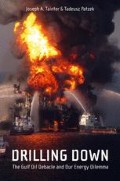Abstract
If fish were scientists, suggests our colleague T. F. H. Allen, the last thing they would discover would be water. We are not sure where this saying originates. Something like it appeared in The New York Times in 1920 in a report on a talk by British scientist Sir Oliver Lodge. “Imagine a deep-sea fish at the bottom of the ocean,” lectured Sir Oliver. “It is surrounded by water; it lives in water; it breathes water. Now, what is the last thing that fish would discover? I am inclined to believe that the last thing the fish would be aware of would be water.”1 We like a variant of this conundrum: imagine that you could talk to a fish, and ask the question: Is your nose wet?
Access this chapter
Tax calculation will be finalised at checkout
Purchases are for personal use only
Notes
- 1.
“Lodge Pays Tribute to Einstein Theory.” The New York Times, February 9, 1920.
- 2.
- 3.
- 4.
Patzek, Tadeusz W. Earth, Energy, Environment and Economics. Second Edition. Manuscript in preparation, University of Texas, Austin.
- 5.
- 6.
Mouawad, Jad and Barry Meier. 2010. “Risk-Taking Rises as Oil Rigs in Gulf Drill Deeper.” The New York Times, August 29, 2010.
- 7.
Alaistair Cooper (ed.) 1983. The Times Atlas of the Oceans. Van Nostrand Reinhold, New York. p. 169.
- 8.
David Barstow, David Rohde, and Stephanie Saul, 2010. “Deepwater Horizon’s Final Hours.” The New York Times, December 25. http://www.nytimes.com/2010/12/26/us/26spill.html.
- 9.
Mouawad and Meier, op. cit. (in note 6).
Further Reading
Complexity
Allen, T.F.H., Tainter, J.A., Hoekstra, T.W.: Supply-Side Sustainability. Columbia University Press, New York (2003)
Barstow, D., Rohde, D., Saul, S.: Deepwater Horizon’s final hours. The New York Times, 25 Dec 2010. http://www.nytimes.com/2010/12/26/us/26spill.html
Tainter, J.A.: The Collapse of Complex Societies. Cambridge University Press, Cambridge (1988)
Circumventing the Energy-Complexity Spiral (or not)
Jevons, W.S.: The Coal Question: An Inquiry Concerning the Progress of the Nation and the Probably Exhaustion of Our Coal-Mines, 2nd edn. Macmillan, London (1866)
Owen, D.: The efficiency dilemma: if our machines use less energy will we just use them more? The New Yorker 86, 78 (2010)
Potter, A.: Planet-friendly design? Bah, Humbug. Macleans.Ca. http://www.macleans.ca/article.jsp?content=20070202_154815_4816. Accessed 22 Jan 2011
Strumsky, D., Lobo, J., Tainter, J.A.: Complexity and the productivity of innovation. Systems Research and Behavioral Science. 27, 496–509 (2010)
Energy Returned on Energy Invested and Renewable Energy
Cleveland, C.J.: Net energy from the extraction of oil and gas in the United States. Energy 30, 769–782 (2005)
Hall, C.A.S., Powers, R., Schoenberg, W.: Peak oil, EROI, investments and the economy in an uncertain future. In: David, P. (ed.) Biofuels, Solar and Wind as Renewable Energy Systems: Benefits and Risks. Springer, New York (2008)
Hall, C.A.S., Balogh, S., Murphy, D.J.R.: What is the minimum EROI that a sustainable society must have? Energies 2, 25–47 (2009). http://www.mdpi.com/journal/energies
Kubiszewski, I., Cleveland, C.J., Endres, P.K.: Meta-analysis of net energy return for wind power systems. Renewable Energy 35, 218–225 (2009)
MacKay, D.J.C.: Sustainable Energy–Without the Hot Air. UIT Cambridge, Cambridge (2009)
Tainter, J.A., Allen, T.F.H., Little, A., Hoekstra, T.W.: Resource transitions and energy gain: contexts of organization. Conservation Ecology 7(3), 4 (2003), http://www.consecol.org/vol7/iss3/art4
The Future
Ackerman, F., Stanton, E.A.: The Cost of Climate Change: What We’ll Pay if Global Warming Continues Unchecked. Natural Resources Defense Council, New York (2008)
Daly, H.E.: Steady-State Economics: the Economics of Biophysical Equilibrium and Moral Growth. W. H. Freeman, San Francisco (1977)
Fridley, David: Nine Challenges of Alternative Energy. Post Carbon Institute, Santa Rosa (2010). http://www.postcarbon.org/Reader/PCReader-Fridley-Alternatives.pdf. Accessed 22 Jan 2011
Kemfert, C., Schumacher, K.: Costs of inaction and costs of action in climate protection: assessment of costs of inaction or delayed action of climate protection and climate change. In: Höppe, P., Pielke, R. (eds.) Workshop on Climate Change and Disaster Losses: Understanding and Attributing Trends and Projections, pp. 149–180, Hohenkammer, Germany. http://cstpr.colorado.edu/sparc/research/projects/extreme_events/munich_workshop/full_workshop_report.pdf. Accessed 22 Jan 2011
Proximate and Ultimate Causes
Perrow, C.: Normal Accidents: Living with High-Risk Technologies. Basic Books, New York (1984) (Second edition, 1999, published by Princeton University Press)
Author information
Authors and Affiliations
Rights and permissions
Copyright information
© 2012 Springer Science+Business Media, LLC
About this chapter
Cite this chapter
Tainter, J.A., Patzek, T.W. (2012). Our Energy and Complexity Dilemma: Prospects for the Future. In: Drilling Down. Springer, New York, NY. https://doi.org/10.1007/978-1-4419-7677-2_9
Download citation
DOI: https://doi.org/10.1007/978-1-4419-7677-2_9
Published:
Publisher Name: Springer, New York, NY
Print ISBN: 978-1-4419-7676-5
Online ISBN: 978-1-4419-7677-2
eBook Packages: Earth and Environmental ScienceEarth and Environmental Science (R0)

